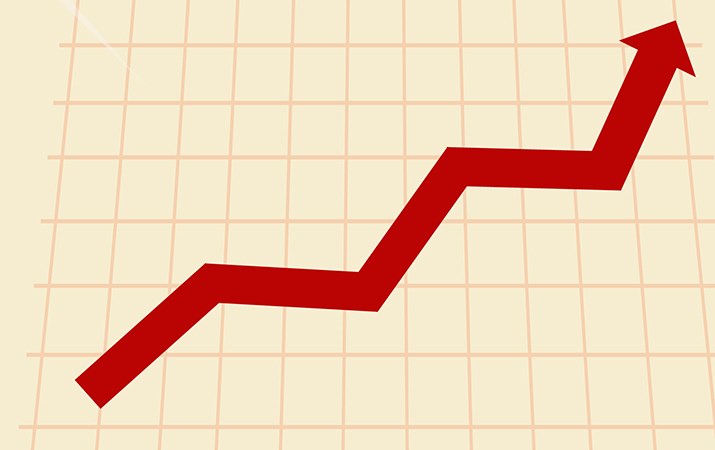
Investors are increasingly choosing passive over active funds. And despite the boom in exchange-traded funds (ETFs), open-ended index funds remain a popular choice for investors looking to track a given market.
As global stock markets continue to soar, it is not surprising that many investors are opting to choose tracker funds rather than bet on an active manager. But which are the most popular options for passive investors? We crunch the numbers.
Assets Are Soaring
According to Morningstar Direct, there are 163 index funds available to UK investors. These attracted an incredible £19.37 billion of net inflows in 2019, an 11% increase from the £17.38 billion that investors poured into these funds in 2018. Total assets under management in these funds climbed from £191 billion at the end of 2018 to £247 billion by the end of 2019, according to Morningstar data - a rise of nearly 30%. A huge proportion of the swell in assets - around £37 billion - can be attributed to rising stock markets, highlighting just why these funds are so popular.
The performance of equity markets, particularly in the second half of 2019, has been the key driving force behind the substantial jump in index fund assets, says Jose Garcia-Zarate, Morningstar's associate director of passive strategies research.
High-profile fee cuts by iShares and Vanguard among others have also helped drive for demand for trackers. He says: "This only enhances the appeal of passives at a time when the reputation of active management in the UK has been dented in the wake of the Woodford debacle."
Ryan Hughes, head of active portfolios at AJ Bell, agrees that the decreasing cost of passive investing is a major draw for investors. The growing size and scale of the index providers is likely to continue this trend, making it incredibly cheap to achieve the same return as a given stock market, with average fees now below 0.10%.
While innovation in the ETF space means investors can track virtually anything these days, it is the simple products that seems to attract the most attention. Much of the money flooding into passive funds goes into those that track the UK or US stock markets, while corporate bond trackers are also popular.
The below table shows the 10 passive funds which saw the greatest inflows in 2019. The Vanguard FTSE UK All-Share Index fund is top of the list, having attracted £1.8 billion of investor money in the year, bringing its total assets to £10.7 billion. The fund has recently been upgraded to Gold by Morningstar analysts and is one of three in the list to hold a Gold Morningstar Analyst Rating.
Dimitar Boyadzhiev praises the tracker’s low fees and efficiency at tracking its benchmark, the FTSE All Share. He adds: “The FTSE All-Share is a broad and diversified index that has proved a formidable opponent to beat.”
|
Top 10 Funds by Flows |
Analyst Rating |
2019 total flows |
|
|
Vanguard FTSE UK All Share Index |
Gold |
£1.81 billion |
|
|
ASI Global Corporate Bond Tracker |
N/A |
£1.62 billion |
|
|
BlackRock ACS World ex UK Equity Tracker |
N/A |
£1.57 billion |
|
|
Vanguard FTSE Developed World ex UK Equity Index |
Silver |
£1.14 billion |
|
|
HSBC American Index |
Gold |
£979 million |
|
|
Aviva Investors Japanese Equity Index UK Fund of Funds |
N/A |
£928 million |
|
|
iShares Emerging Markets Equity Index |
N/A |
£861 million |
|
|
iShares Corporate Bond Index |
Bronze |
£850 million |
|
|
State Street ACS Multi-Factor Global ESG Index |
N/A |
£840 million |
|
|
iShares UK Equity Index |
Silver |
£818 million |
Last year was a strong one for the US market and both the S&P 500 and Dow Jones indices hit record highs through 2019. Unsurprisingly, this piqued investor interest and proved a boon for US tracker funds. Indeed, investors put £978 million into Gold-rated HSBC American Index last year, earning it fifth spot in the list. This trend is reflected in the wider category flow data for 2019 too: the US Large-Cap Blend Equity, which covers value and growth stocks, saw the greatest inflows of any Morningstar category, at £5.4 billion.
Bonds Dominate Flows
Even with equities hitting new peaks, 2019 saw a renewed interest in bonds, and investors are increasingly looking to passive options to access this asset class. Two of the top 10 funds were fixed income options: the ASI Global Corporate Bond Tracker is number two in our list, while Bronze-Rated iShares Corporate Bond Index made it to eighth spot. The funds achieved inflows of £1.62 billion and £850 million in 2019 respectively.
While government bonds were also popular last year, corporate bond funds are often more sought-after by those looking for income, particularly as many government bonds in developed markets offer tiny or negative yields.
Across the three Morningstar fixed income categories - Global Emerging Markets Bond, Global Bond and GBP Bond - the asset class saw inflows of £6.9 billion. The table below shows the 2019 inflows achieved by passive funds in each Morningstar category. Here it is clear that equities still take the lion's share of inflows at almost £12.5 billion. While the US Large-Cap Blend Equity sector saw the biggest inflows in 2019 at £5.41 billion, it is the UK Large-Cap Equity sector which is the biggest overall, with total assets coming in at a hefty £62.79 billion. The next largest categories by assets are not quite half the size: US Equity Large Cap holds £30 billion of investor money, and GBP Bond £29 billion.
|
Morningstar Category |
2019 total flows |
Assets - Dec 2019 |
|
US Large-Cap Blend Equity |
£5.41 billion |
£30.2 billion |
|
Global Bond |
£3.71 billion |
£5.42 billion |
|
GBP Bond |
£2.90 billion |
£29.06 billion |
|
UK Large-Cap Equity |
£1.40 billion |
£62.79 billion |
|
Asia-Pacific ex-Japan Equity |
£1.20 billion |
£2.84 billion |
|
Global Emerging Markets Equity |
£1.11 billion |
£3.84 billion |
|
Europe ex-UK Equity |
£1.10 billion |
£11.42 billion |
|
Global Large-Cap Blend Equity |
£936.81 million |
£14.18 billion |
|
Japan Large-Cap Equity |
£842.35 million |
£5.08 billion |
|
Global Emerging Markets Bond |
£346.41 million |
£2.32 billion |
|
Sector Equity Infrastructure |
£269.46 million |
£454 million |
|
UK Mid-Cap Equity |
£213.35 million |
£2.53 billion |
|
Property - Indirect Global |
£163.99 million |
£3.54 billion |
|
Sector Equity Technology |
£121.19 million |
£552 million |
|
Sector Equity Healthcare |
£-21.76 milllion |
£496 million |
|
GBP Flexible Allocation |
£-91.06 million |
n/a |
|
Other Equity |
£-263.85 million |
n/a |
UK index funds have performed well in an otherwise challenging year for fund flows, says James Crossley, head of UK retail sales at Legal & General Investment Management. The election result also helped improve sentiment - and therefore fund flows - back to the UK.
While tracking the main stock markets is the most common way investors use passive funds, he says there is a growing trend towards accessing alternative assets such as listed infrastructure and real estate through trackers, as well as sector exposure such as technology. According to Morningstar data, the infrastructure category received £269 million of inflows last year. However, healthcare was one of just three categories to experience net outflows in the year, suggesting that sector specific trackers are also vulnerable to swings in sentiment.
Still, Crossley expects the trend to continue: "This could be an exciting area as investors look to incorporate new disruptive technology into portfolios." He also thinks ESG passive funds to experience significant growth in the coming years.
Sustainable Investing Takes Off
Last year was a pivotal one for sustainable investing as the climate crisis forced its way on to the agenda. While there is not a specific Morningstar category for Sustainble or ESG-focsued funds, we can still see the flows into funds with these remits.
One passive tracker made it into the top 10 funds by flows: State Street ACS Multi-factor Global ESG Index, with £840 million of net inflows. Launched at the end of 2018, the fund aims to track the MSCI World Select 5‐Factor ESG Low Carbon Target Index.
European sustainable flows hit record levels in 2019, as did the number of fund launches - passive funds now make up around 20% of assets under management for sustainable funds in Europe. Globally, 2019 saw a record amount of sustainable fund launches but Morningstar is making it easier to distinguish between funds with "ESG considerations" to those that put sustainable investing at the core of their strategy.
Jon Hale, head of sustainable research at Morningstar, says: "With growing investor interest in sustainable investing, especially among younger investors, 2019's flows may be the leading edge of a huge wave of assets to come."























